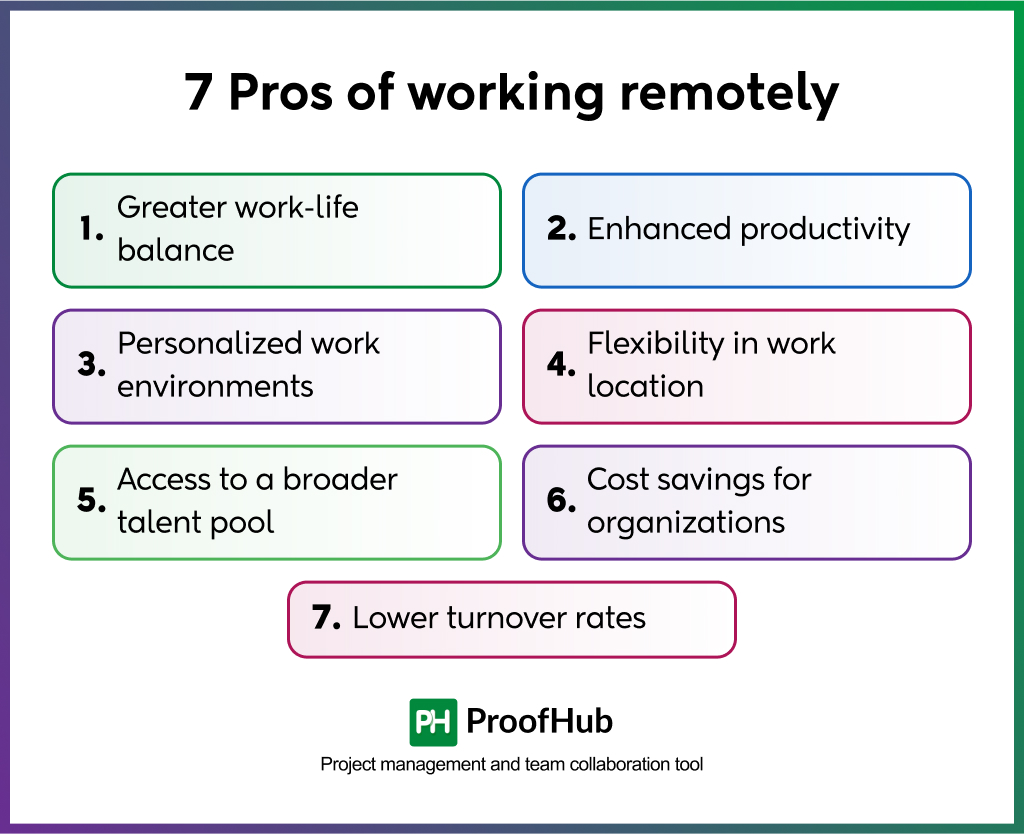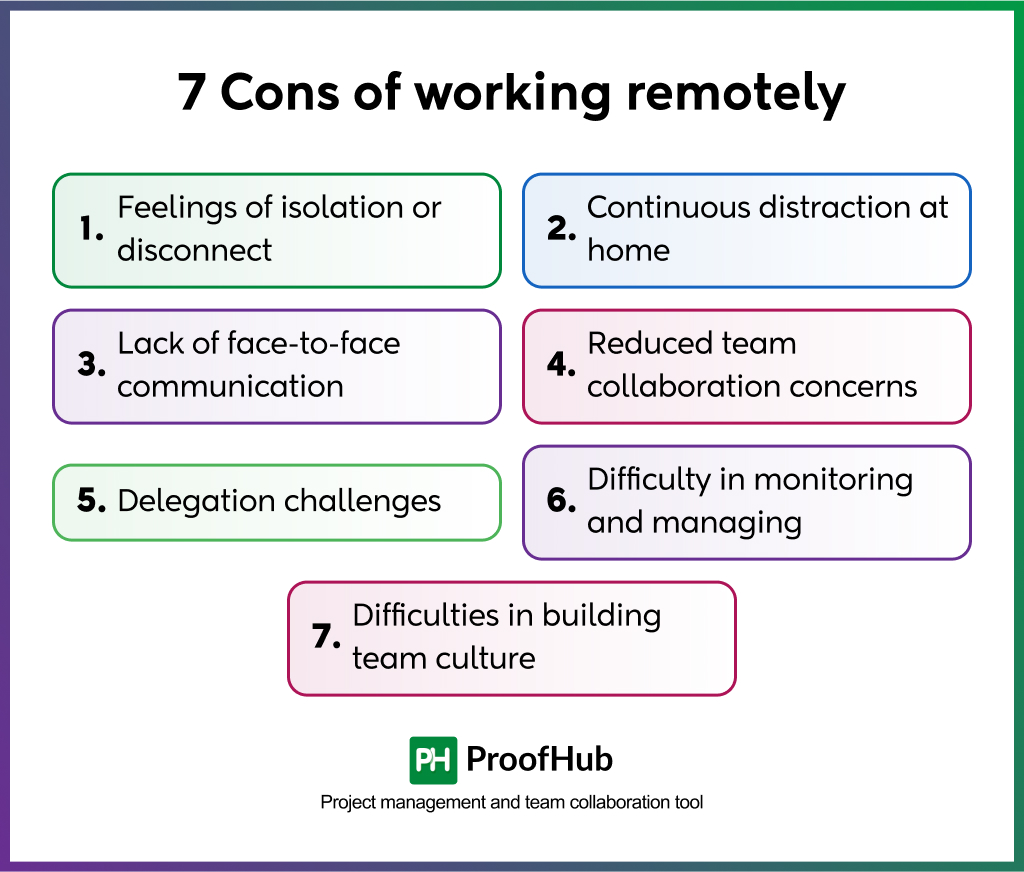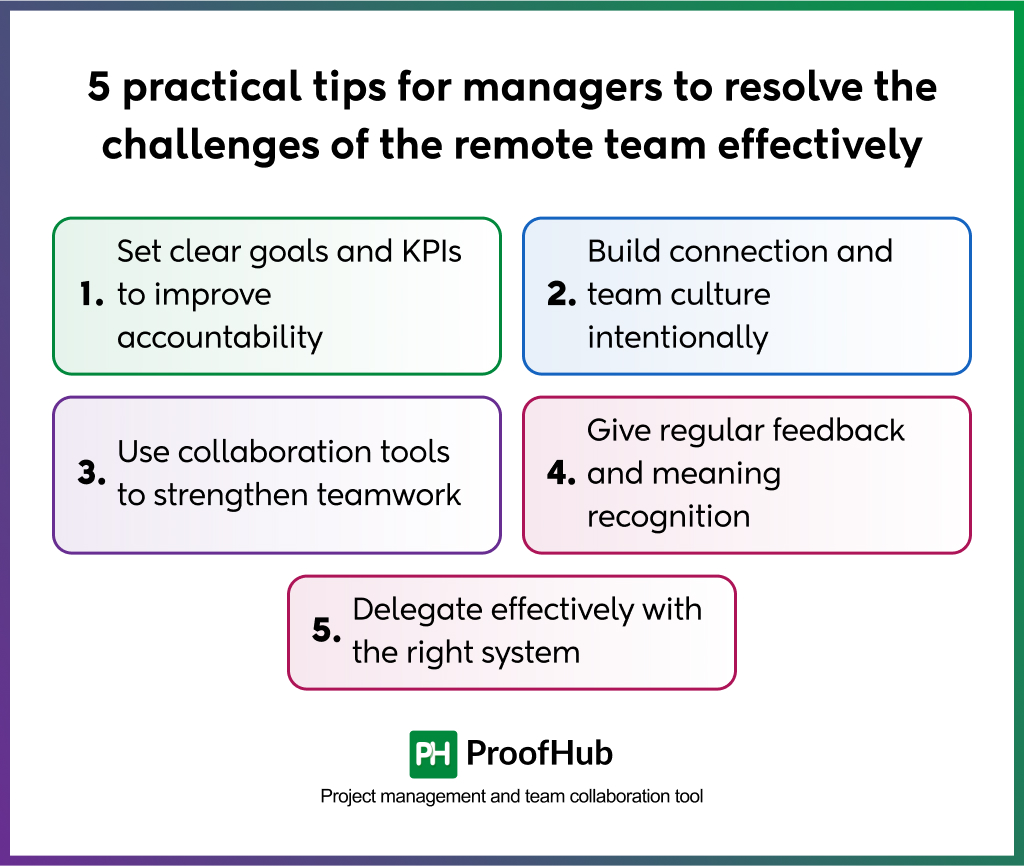Before jumping into something new, we naturally weigh the pros and cons.
Remote work is no different. As more teams shift toward flexible work models, many ask a key question: Is working from home truly effective?
Being a CMO at a SaaS company, I often hear two types of feedback from remote teams:
“We’re more productive than ever.”
And “We feel disconnected and out of sync.”
That’s the double-edged sword of remote work.
Remote work has clear benefits, but it also comes with real challenges.
Not just for employees and employers, but also for managers who manage a remote team.
In this blog, we will look at the pros and cons of remote work and explore how you can effectively resolve the challenges of managing a remote team.
Remote work pros and cons – A quick overview
To help you understand both the pros and cons of remote work, here is a quick breakdown:
| Remote work Pros | Remote work Cons |
|---|---|
| Greater work-life balance | Feelings of isolation or disconnect |
| Enhanced productivity | Continuous distraction at home |
| Personalized work environments | Lack of face-to-face communication |
| Flexibility in work location | Reduced team collaboration concerns |
| Access to a wider talent pool | Delegation challenges |
| Cost savings for organizations | Difficulty in monitoring and managing |
| Lower turnover rates | Difficulties in building team culture |
7 Pros of working remotely
Based on my experience working with remote teams, here are seven key benefits of remote work.

1. Greater work-life balance
According to research by Hubstaff, 85% of workers say remote work would make it easier for them to balance work and life. And it’s not hard to see why. Remote work eliminates travel time so employees can spend extra time with family or loved ones.
As Darren Murph, Head of Remote at GitLab, puts it:
“Remote work isn’t just a location strategy—it’s a lifestyle strategy. When done right, it empowers people to structure their lives in a healthier, more fulfilling way.”
Discover 13 Proven work-life balance tips for overworked professionals
2. Enhanced productivity
Without the daily grind of commuting and constant office distractions, employees can dive into their work with better focus and energy.
In fact, according to Owl Lab’s 2022 State of Remote Work Report, 62% of workers said they feel more productive when working remotely, while only 11% felt less productive.
A big reason behind this? Employees have the freedom to shape their work environment. Whether it’s a quiet room, a favorite playlist, or simply fewer interruptions, creating a personalized setup at home helps them stay focused and deliver better results faster.
Also, remote working offers more flexibility in the schedule. Remote work allows employees to design their day when they’re most productive and need personal time. Whether taking a walk at lunch or simply napping, it all adds to a more balanced, satisfying life.
3. Personalized work environments
Remote work empowers employees to tailor their workspace to suit their comfort and productivity. Whether choosing a quiet, distraction-free space, adjusting the room temperature for comfort, or playing background music to aid concentration, having control over their environment helps employees stay focused, feel more energized, and perform at their best.
4. Flexibility in work location
Remote work allows employees to choose where they live without compromising their careers. It empowers individuals to leave behind high-rent cities and settle in locations that align better with their personal preferences, family needs, and financial goals.
Today, employees can build a meaningful career from anywhere without uprooting their lives for a job.
5. Access to a broader talent pool
Taso Du Val, CEO of Toptal, says:
“Remote work has empowered companies to hire the best talent, regardless of where they live. It’s no longer about where someone sits but what they bring to the table.”
As an employer, you can hire skilled professionals worldwide, bringing fresh perspectives, diverse experiences, and hard-to-find expertise that might not exist in their local area.
This global reach expands hiring options and brings fresh ideas through diverse perspectives.
6. Cost savings for organizations
Remote work brings financial benefits for both employers and employees. Companies can save on infrastructure expenses. For example, IBM saved $50 million in real estate by reducing its office footprint.
It also allows you to recruit top professionals in lower-cost regions or countries. Hiring a product manager from Houston, for instance, may cost significantly less than one from San Francisco, with no loss in expertise.
7. Lower turnover rates
With remote work, you can reduce staff turnover because employees value the flexibility it provides. When employees feel trusted to manage their time, it leads to higher job satisfaction and stronger emotional commitment to their work. This boosts morale and reduces the disruptions associated with frequent hiring and onboarding.
7 Cons of working remotely

Even though remote work has a lot of benefits, it’s not the best fit for everyone. Remote work has challenges that can affect how teams work together and stay connected. Based on my experience working with remote teams, here are seven cons of remote work.
1. Feelings of isolation or disconnect
Humans are not built to live alone. We’re wired for connection. That’s why remote work, while flexible and convenient, isn’t always ideal for those who thrive on hallway chats, team lunches, or seeing friendly faces at the office. Without those daily touchpoints, working from home can sometimes feel isolating.
2. Continuous distraction at home
While working from home, it’s easy to get pulled away from work tasks by household chores, family members, or other personal obligations.
The line between “home” and “office” can get blurry—one minute, employees answer emails, and the next, they are folding laundry or helping with homework. Unlike the office, where the environment is designed for focus, working from home requires more effort to set boundaries and stay on track.
3. Lack of face-to-face communication
As employees aren’t all located in the same space, like the office, they can’t swing by someone’s desk to ask questions or pop into a collaboration space for a quick meeting.
The absence of face-to-face interaction can affect collaboration, team trust, and engagement. The research backs this up.
According to research from the Oxford Review, building trust is harder in virtual teams, especially when fewer opportunities exist for natural, human connection.
Even more striking, the MIT Sloan Management Review revealed that face-to-face requests are 34 times more successful than those made over email—a powerful reminder that communication isn’t just about the message but the medium.
4. Reduced team collaboration concerns
In remote work, having those friendly moments like saying “good morning” when you walk into the office or sharing a quick joke between tasks is harder. These simple interactions help build trust and make teamwork feel more natural.
If remote teams only talk about work and skip informal chats, it can create distance between coworkers. Employees may feel uncomfortable asking for help or sharing problems that affect their work.
5. Delegation challenges
One of the significant concerns I faced as a manager in remote work was delegation. Without being in the same physical space, it was harder to judge who was available, who was doing what, what their next task would be, etc.
This lack of visibility often led to confusion or delays, as I could not easily gauge workload distribution or identify the right person for each task.
6. Difficulty in monitoring and managing
After delegation, another aspect that is difficult in remote work is monitoring and managing. In a remote setup, it’s not as easy to observe employee performance or catch early signs of disengagement. As a result, monitoring performance and productivity becomes less visible and more complex.
Managers often find themselves asking:
- Is everyone staying on track?
- Is someone struggling in silence?
- Are deadlines slipping because of miscommunication?
Discover the 15 Strategies for managing remote teams effectively
7. Difficulties in building team culture
Building a team culture in remote work is difficult because interactions are often limited to tasks and meetings. Without casual conversations or unplanned moments of connection, it’s harder for team members to form strong relationships or feel a sense of belonging.
Managers often find themselves asking questions like
- “Do you feel connected to the team?”
- “What helps you feel included?”
- “Do you miss casual chats?”
- “How can we make work more fun?”
Now you know both the pros and cons of remote work, so let’s find out how managers can overcome its challenges
5 Practical tips for managers to manage remote team effectively

Below are practical solutions for each key issue, broken down into helpful advice for your team and actionable steps you can take as a manager.
1. Set clear goals and KPIs to improve accountability
One of the biggest challenges in remote teams is not being able to “see” how employees work. This makes it harder to know if everyone is on track or struggling silently.
To solve this problem, set clear goals and KPIs (key performance indicators) for every team member.
Employees can work more independently and confidently when they know what is expected.
How to set clear goals and KPIs:
- Make goals specific and measurable; for example, instead of saying,” improve customer support, ” respond to all customer queries within 24 hrs and achieve a 90% satisfaction rating.
- Align goals with team and company objectives so team members understand how their work contributes to the bigger picture.
- Break goals into weekly or monthly targets to avoid last-minute rushes or missed deadlines.
2. Build connection and team culture intentionally
Try to create intentional time for human connection, not just work talk. This could be as simple as:
- Weekly casual check-ins (no agenda, just chatting)
- Virtual coffee breaks or lunch hangouts
- Fun team channels for hobbies, pets, memes, or weekend stories
- Team-building activities like online games, quizzes, or show-and-tell sessions
3. Use collaboration tools to strengthen teamwork
You can use online team collaboration tools. These digital platforms help teams collaborate by offering features such as instant messaging, file sharing, comments, proofing, discussion boards, and more.
4. Give regular feedback and meaning recognition
In remote work, silence can kill productivity. Team members often don’t know if they’re doing well or falling short unless someone tells them.
How to give constructive feedback:
- Be clear and kind: Focus on the behavior, not the person. Say, “The report was missing key data points,” instead of “You weren’t thorough.”
- Explain the impact: Help them understand why it matters. “Missing data could affect the client’s decision-making.”
How to give meaningful recognition:
- Be specific: Instead of saying, “Nice work,” say, “I appreciate how you handled the delegation today—it was structured and professional.”
- Make it timely: Don’t wait. Recognize the efforts as soon as possible to maintain their impact.
- Celebrate publicly: Praise in team meetings, group chats, or with a shout-out on your project management tool.
Also read: How to give effective project feedback
5. Delegate effectively with the right system
To delegate tasks effectively, you can use project management tools like ProofHub. It makes delegation simple, transparent, and stress-free for managers. How ProofHub can help:
- Assign tasks with clarity: With ProofHub, you can assign tasks to specific team members, add deadlines, attach files, and write clear instructions—all in one place.
- Custom workflows: You can set the workflow according to your needs and use different project workflows.
- Track progress in real-time: You can use progress tracking to see what’s done, what’s pending, and what needs your attention.
- Centralize communication: Add comments, real-time chat, @mention teammates, and share feedback within tasks.
Conclusion
Remote work isn’t perfect—it has its pros and cons. In pros, you will get a greater work-life balance, location freedom, and enhanced productivity. In cons, you will get feelings of isolation, continuous distraction at home, communication gaps, and delegation challenges. However, you can easily reduce those challenges with the right mindset, system, and support.
You can use project management and team collaboration software like ProofHub to make work from home more effective. It will bring everything your team needs into one place, like task assignments, deadlines, progress tracking, communication, and file sharing, so nothing falls through the cracks.
Frequently asked questions about working remotely
Is working remotely effective?
Remote work is practical, but evaluating its advantages and disadvantages is better. While it offers flexibility, work-life balance, and increased productivity, it also comes with challenges like communication gaps, feelings of isolation, and team management. Understanding both sides helps you to make better decisions.
What are the challenges of remote working?
One of the biggest challenges is miscommunication. Without in-person conversations, it’s easy for messages to get lost in the loop. You may also face difficulties in monitoring productivity and engagement, which can lead to trust issues or micromanagement.
Another common challenge is the feeling of isolation, as remote workers miss out on the social interaction and sense of belonging from being part of a physical workplace.
What’s the ideal setup for remote work at home?
- A good ergonomic chair
- A height-appropriate desk
- A reliable laptop or desktop
- An external monitor if your work involves multitasking
- Strong Wi-Fi is non-negotiable
- Good headphones or a headset with a mic
- Notebooks, chargers, or sticky notes
- A plant, a cozy mug, or anything that makes your space feel motivating
How do companies track remote employee performance?
Platforms like ProofHub give managers a bird’s-eye view of who’s working on what, task progress, and any bottlenecks in project management. With features like task assignments, time tracking, and project milestones, teams stay organized and accountable without constant check-ins.

